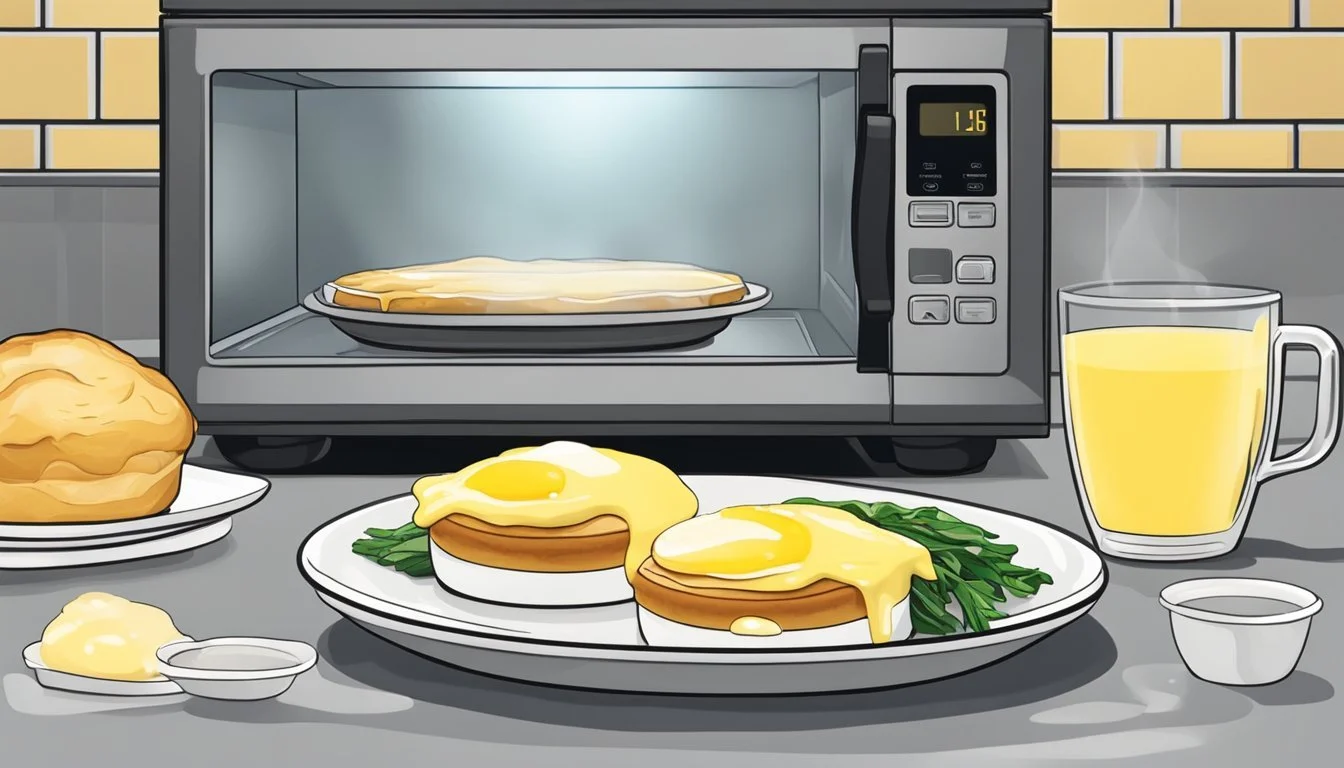Best Way to Reheat Eggs Benedict
Ensuring Creamy Hollandaise and Crisp Muffins
Eggs Benedict, a classic brunch (What wine goes well with brunch?) favorite, presents a unique challenge when it comes to reheating leftovers without compromising the quality of its components. The dish comprises an English muffin, topped with ham or bacon, a poached egg, and a generous pour of hollandaise sauce. To bring leftover Eggs Benedict back to its original glory, particular attention must be paid to each layer to ensure the hollandaise remains creamy, the muffin crisp, and the egg delicately warmed.
The hollandaise sauce, sensitive to temperature, is prone to breaking or curdling if improperly heated. It demands a low and gentle warming process. The English muffin, on the other hand, benefits from a method that encourages a return to its original toasted crispness without becoming overly hard. The poached egg, central to the dish, requires careful handling to warm through without cooking further and losing the coveted runny yolk.
By addressing each of these elements with tailored reheating techniques, one can revive Eggs Benedict in a manner that maintains the integrity and balance of textures and flavors. This article aims to guide the reader through the optimal reheating methods to achieve a result that pays homage to the freshly made version of this beloved dish.
Understanding Eggs Benedict
Eggs Benedict is a sophisticated traditional American breakfast or brunch dish that combines several textures and flavors.
Components of Eggs Benedict
Eggs Benedict primarily consists of four components layered carefully to create its signature taste and presentation:
English muffins: They act as a base and are typically toasted to offer a crisp texture.
Ham: A slice of ham is placed on top of each muffin half, adding a savory note.
Poached eggs: Sitting atop the ham, the poached eggs should have a runny yolk that, when broken, adds a creamy element to the dish.
Hollandaise sauce: The dish is finished with a generous pour of hollandaise sauce, contributing a rich and buttery flavor.
The Importance of Hollandaise Sauce
Hollandaise sauce is a crucial element in Eggs Benedict. It is an emulsion of egg yolks, melted butter, and lemon juice or vinegar, often seasoned with salt, and white or cayenne pepper. Hollandaise sauce not only provides a luxurious creaminess but also binds the ingredients' flavors, creating a harmonious balance that characterizes this beloved brunch item. The technique for crafting a smooth hollandaise sauce is intricate and requires skill to achieve the perfect consistency and warmth.
Preparation for Reheating
When reheating Eggs Benedict, proper storage and handling of the individual components is essential to maintain the quality of the dish. These techniques ensure that each element retains its intended flavor and texture during the reheating process.
Storing Leftover Eggs Benedict
Leftovers should be stored methodically to preserve their freshness. One should place Eggs Benedict in an airtight container before refrigerating to prevent moisture loss. It is crucial to separate the hollandaise sauce from the poached eggs, ham, and English muffins to avoid sogginess. The sauce should be kept in a separate container in the fridge, while the poached eggs can be wrapped gently in cling film or stored in a container with a lid. The English muffins and ham should also be refrigerated, preferably in a compartment that minimizes moisture exposure.
Separating Components Before Reheating
Before reheating, one must separate the Eggs Benedict components to ensure each can be heated in a way that is most suitable for its texture. The English muffins should be crisped up, ideally in an oven or toaster, to bring back their crunch. The ham can be reheated using a pan or placed in the microwave, if necessary. Poached eggs require gentle reheating, which can be achieved by placing them in simmering water for a brief period. They must be handled delicately to avoid overcooking. The hollandaise sauce poses the greatest challenge, as it can easily split. It should be warmed at a low temperature, either in a double boiler or in the microwave at a reduced power setting, stirring regularly to maintain a creamy consistency.
Tools and Techniques for Reheating
Reheating Eggs Benedict requires careful attention to each component to maintain the dish's integrity. Adequate tools and precise methods are key to keeping the hollandaise sauce creamy, the English muffin crisp, and the poached eggs warmed to the correct consistency.
Methods to Reheat Hollandaise Sauce
To reheat hollandaise sauce, one should employ gentle heat to prevent separation. A double boiler or a heatproof bowl set over simmering water is an effective tool. The water should be hot but not boiling, and the sauce should be stirred consistently with a whisk to maintain a smooth texture. A microwave can also be used with caution; one should heat the sauce in a microwave-safe dish, using low power and short bursts, stirring between intervals.
Stovetop Double Boiler
Set up the double boiler with simmering water.
Place the sauce in the top bowl and whisk constantly.
Microwave (with caution)
Use low heat setting.
Heat for 15-20 seconds, stir, and repeat as necessary.
Achieving a Crisp Muffin and Warm Ham
To reheat the English muffin and ham while preserving the desired textures, a skillet or oven should be used to apply a dry heat that toasts the muffin and warms the meat without making them soggy. The muffin halves and ham slices can be placed in a single layer in the skillet and heated over low heat, turning occasionally to ensure even warming and to achieve a light crisp on the outside.
In a Skillet
Place on low heat.
Turn the muffin and ham occasionally for even browning.
In the Oven
Arrange on a baking sheet.
Heat at a low temperature until crisp and warm.
Warming Poached Eggs Without Overcooking
To successfully warm poached eggs, one should avoid introducing them directly to high heat, which can cause the yolks to overcook and the whites to become rubbery. Instead, the eggs can be gently reheated by placing them in warm water for a short time. A small pot of water brought to a simmer, with a splash of vinegar, aids in keeping the egg whites intact, and should be used as a water bath where eggs are submerged for no longer than one minute to retain the ideal consistency.
In a Simmering Water Bath
Add a splash of vinegar to the water.
Submerge eggs for 45-60 seconds for optimal warmth without overcooking.
Troubleshooting Common Reheating Problems
When reheating Eggs Benedict, one aims to maintain the quality of each component. The sauce should stay creamy, the muffin crisp, and the eggs perfectly warmed without overcooking.
Preventing Sauce from Splitting
The hollandaise sauce can split if subjected to high heat. To avoid this, one should gently reheat the sauce using a double boiler method: place the sauce in a heatproof bowl set over a pot of simmering water, stirring constantly, until just warm. This indirect heat helps to emulsify the sauce without causing the egg yolk and melted butter to separate.
Method: Double Boiler
Heat: Indirect / Low
Tools: Heatproof Bowl, Pot
Instructions:
Continuously stir
Do not allow the bowl to touch boiling water
Avoiding Soggy Muffins
A soggy English muffin can ruin the experience. To keep it crisp, reheat it in a skillet over medium heat until it regains its crispness. By using a paper towel to absorb excess moisture, one ensures that the muffin does not get soggy while being warmed.
Method: Skillet
Heat: Medium
Tools: Skillet, Paper Towel
Instructions:
Heat each side for about a minute
Use a paper towel to blot moisture
Ensuring Evenly Reheated Eggs
Poached eggs should be warmed without overcooking the whites or the yolk. To achieve this, submerge the eggs in a pot of hot (not boiling) water for no more than 45 seconds. Transferring them onto a paper towel post-heating will help remove water without cooking them further.
Method: Water Bath
Temperature: Just below simmering
Tools: Pot, Slotted Spoon, Paper Towel
Instructions:
Immerse eggs for 45 seconds
Remove with a slotted spoon and drain on a paper towel
Serving and Presentation
A well-reheated Eggs Benedict retains the delicate balance of textures and flavors, crucial for a dish that often stars on social media platforms like Instagram and Pinterest. The final presentation can capture the irresistible homemade quality that many strive to share on Facebook and Twitter.
Recommended Sides and Garnishes
Garnishes: A sprinkling of finely chopped chives and parsley not only adds a pop of color but also enhances the flavor without overpowering the dish. For the best texture, garnish with these herbs right before serving to maintain their crispness.
Texture: To maintain or add crunch, serving a side of sautéed potatoes or a lightly dressed salad offers a delightful contrast to the creamy hollandaise and soft poached eggs.
Salt and pepper: A small dish of salt and pepper on the side allows guests to season their dish to taste, personalizing the experience of each bite.
Plating Eggs Benedict after Reheating
Muffin: Ensure the English muffin has retained its crispness during reheating to provide a firm base for the toppings. A slightly toasted texture is ideal.
Presentation: Serve the reheated Eggs Benedict on a warm plate. Drizzle or spoon the creamy hollandaise sauce over the eggs, allowing a little to cascade down the sides for a visually appealing effect.
For a truly impactful presentation, one should be mindful of the balance of colors and textures on the plate, aiming to appeal not only to the taste buds but also to the artistic appreciation of the dish.
Food Safety Considerations
When it comes to reheating Eggs Benedict, ensuring food safety is just as important as achieving the perfect texture and flavor. Leftover Eggs Benedict needs to be stored correctly to minimize the risk of spoilage, and it is crucial to be able to identify when the dish has gone bad.
How to Tell If Leftovers Are Spoiled
To determine if leftover Eggs Benedict is no longer safe to eat, one should look for the following signs:
Odor: A sour or unpleasant smell is a clear indicator that the Eggs Benedict has gone bad.
Texture: If the Hollandaise sauce has separated or the muffin has become excessively soggy, these are signs that the quality has degraded.
Color: Any discoloration on the eggs, ham, or sauce should raise concern.
Best Practices for Leftover Food Safety
For safe storage and consumption of leftover Eggs Benedict:
Refrigeration: Leftovers should be stored in the fridge within two hours of cooking to slow the growth of bacteria. Keep them at or below 40°F (4°C).
Containers: Use air-tight containers to protect against contaminants and moisture.
Consumption Window: Consume refrigerated leftovers within 3-4 days to ensure safety.
Reheating: Ensure the entire dish reaches an internal temperature of 165°F (74°C) when reheating to eliminate any potential bacteria.
By following these specific guidelines, one can enjoy leftover Eggs Benedict with confidence in both its safety and quality.
Alternative Uses for Leftover Eggs Benedict
Transforming leftover Eggs Benedict into fresh culinary creations or breakfast variations gives new life to what might have been discarded. This section will explore how to deconstruct the components of Eggs Benedict to craft delightful new dishes or reinvent the breakfast experience.
Creating New Dishes with Leftovers
Leftovers provide an opportunity for culinary innovation. The poached eggs from an Eggs Benedict—provided they are still within a safe timeframe for consumption—can be reheated gently to maintain their delicate texture and incorporated into salads or placed atop roasted vegetables for a protein boost. The hollandaise sauce, with its creamy consistency, serves as a superb new base for homemade dips or as a dressing when emulsified with a bit of vinegar and olive oil.
Ingredients:
Leftover poached eggs
Leftover hollandaise sauce
New Dishes Ideas:
Salad Topper: Place a gently reheated poached egg on a bed of greens.
Hollandaise Dip: Combine hollandaise with cream cheese and herbs for a flavorful dip.
Veggie Boost: Use reheated eggs and sauce to create a warm vegetable topping.
Incorporating Leftovers into Breakfast Variations
Those who favor breakfast classics can creatively repurpose their Eggs Benedict. The English muffin, once crisped up again in a toaster or oven, can serve as the foundation for a variety of breakfast sandwiches, with or without the original toppings. Scramble leftover poached eggs and combine them with additional ingredients like cheese, ham, or fresh herbs to build a new breakfast delight. Alternatively, use the hollandaise sauce to add richness to a plate of scrambled eggs or in place of butter on warm, buttery biscuits.
Breakfast Reimagining:
English Muffin Sandwiches: Toast the muffins and add fresh toppings.
Hollandaise Scrambled Eggs: Mix the sauce into scrambled eggs for added flavor.
Biscuit Spread: Replace butter with leftover hollandaise on biscuits for a decadent treat.
Exploring Variations of Eggs Benedict
Eggs Benedict, a classic brunch favorite, has inspired various adaptations that cater to diverse dietary preferences and offer a twist on traditional flavors. These variations focus on ingredient substitutions and creative reimagination.
Health-Conscious Substitutes for Traditional Ingredients
For those looking to enjoy Eggs Benedict with fewer calories or more nutrients, several substitutions are available:
Canadian Bacon: Replace with leaner proteins like turkey bacon or smoked salmon.
Hollandaise Sauce: Opt for yogurt-based sauces or light vinaigrettes to reduce calorie intake.
English Muffin: Use whole grain alternatives or even portobello mushroom caps for a gluten-free base.
Adding vegetables such as tomatoes, asparagus, or avocado can boost the nutritional profile and introduce new textures and flavors. Poached eggs remain a staple in these health-conscious variants, retaining the iconic element of Eggs Benedict.
Creative Twists on Classic Eggs Benedict
Creativity in the kitchen transforms traditional Eggs Benedict into unique and memorable dishes:
Avocado Toast Benedict: Incorporating avocado as a rich, creamy base instead of an English muffin adds a modern spin.
Caprese Benedict: Layer sliced tomatoes and fresh mozzarella with basil leaves for an Italian flair.
Southwest Benedict: Introduce potatoes as crispy hash browns and a spicy hollandaise to infuse bold Southwestern flavors.
Each variation retains the integrity of the dish while playing with flavor combinations to produce delectable and surprising new ways to savor Eggs Benedict.
Conclusion
Proper reheating of Eggs Benedict is crucial to enjoy a breakfast or brunch that preserves the dish’s distinct texture and flavor. To maintain the creamy consistency of the hollandaise sauce, gentle heating is recommended, with preference given to methods that avoid direct heat. The sauce should ideally be warmed separately to prevent it from splitting and losing its velvety texture.
When reheating the components of Eggs Benedict, careful attention must be paid to each element:
English Muffins: Toasting is the key to ensuring they remain crisp and not soggy. A toaster oven or skillet can achieve the desired crispiness.
Poached Eggs: A short simmer in hot water is sufficient for warming through without further cooking the yolk.
Canadian Bacon or Ham: Lightly heat in a pan just until warmed through to avoid drying out.
Reheaters should remember that combining the components after individual heating preserves the integrity of Eggs Benedict. Microwaving is a less preferred method, as it risks ruining both the texture of the muffin and poached egg but can be done carefully on a low setting, covered, and in short intervals to retain moisture.
The goal is always to replicate the freshly made experience of Eggs Benedict with each element reheating compatibly to ensure the final dish's quality. Observing these methods ensures the dish is brought back to life in the most appetizing way possible.











